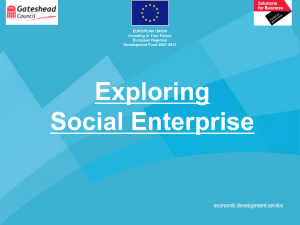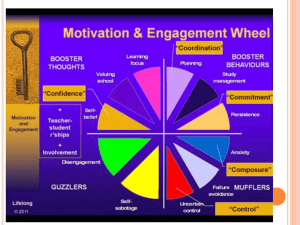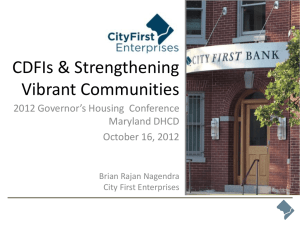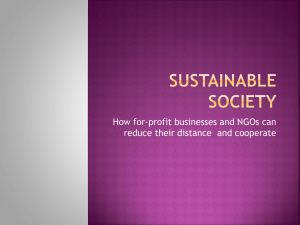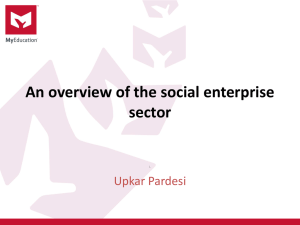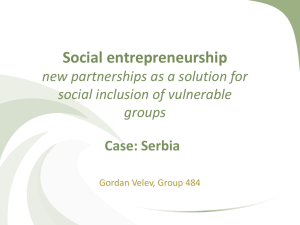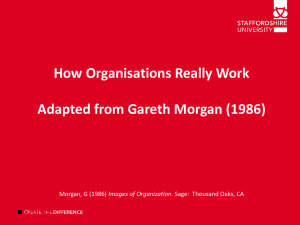Jo Barraket/Craig Furneaux - Challenge Social Innovation
advertisement
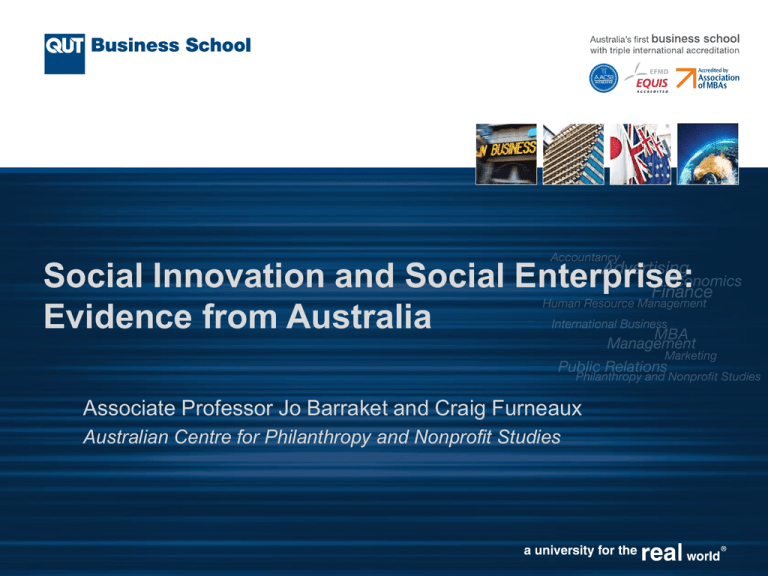
Social Innovation and Social Enterprise: Evidence from Australia Associate Professor Jo Barraket and Craig Furneaux Australian Centre for Philanthropy and Nonprofit Studies Acknowledgements • More than 570 participants in the Finding Australia’s Social Enterprise Sector project • Social Traders (research partner) and Westpac Foundation • ACPNS colleagues: Dr Nick Collyer, Matt O’Connor, Dr Heather Anderson Background and Context • There is a growing interest in social innovation, both in Australia and internationally • Movement both includes and contests social economy organisations • Despite growing interest ,there is little known about the nature of social innovation within the social economy • This paper reports on a research project undertaken to identify the population and practices of social enterprises in Australia. Definition of social enterprise • There are competing definitions of social enterprise. • Based on key informant discussions, the following definition was applied. Social enterprises: – Are led by an economic, social, cultural, or environmental mission consistent with a public benefit; – Trade to fulfil their mission; – Derive a substantial portion of their income from trade; and – Reinvest the majority of their profit/surplus in the fulfilment of their mission. Defining social innovation: • Minimal conceptual development and operational application to date a “novel solution to a social problem that is more effective, efficient, sustainable, or just than existing solutions, and for which the value created accrues primarily to society as a whole rather than private individuals” (Phills et al. 2008: 34) Theoretical framework • Mulgan et al.’s (2007: 5) three dimensions of social innovation are used to explore social innovation in Australia: – new combinations or hybrids of existing elements; – cutting across organisational, sectoral and disciplinary boundaries; – and leaving behind compelling new relationships. Methodology Defining social enterprise – workshops and online discussion paper Communicating with prospective survey respondents Conducting the Survey Data analysis and reporting Size of responding organisations Size of responding organisations (N=218) Percent 80 60 40 20 0 Small Medium Organisational size Large Age of responding organisations Age of responding Social Enterprises 70 60 50 40 30 20 10 0 It is not yet fully operational Less than 2 years 2-5 years 6-10 years More than 10 years Main purpose None of the above We exist primarily to generate financial benefits for individuals We exist primarily to support the mission of our nonprofit auspice We exist primarily to provide benefits to our members We exist primariy to fulfill a public or community benefit Percent Primary Mission Primary Mission of Responding Social Enterprises (N=474) 80 60 40 20 0 80 60 Percent 40 20 0 Other A semi-autonomous entity operating under the auspices of a pre-existing organisation A fully incorporated/registered trading entity A separately incorporated program or subsidiary of a larger organisation An unincorporated/registered entity that is not yet trading An unincorporated group of interested individuals and/or organisations Organisational Structure Organisational Structure of responding Social Enterprises (N=349) Geographic Reach Geographic Reach of the Mission in which responding social enterprises are involved (N=342) 100 Percent 80 60 40 20 0 Local Regional Statewide National Geographic Focus International 0 A spiritual or religious community Aboriginal and Torres Strait Islanders People with alcohol, drug or substance abuse issues Young people A particular geographic community People with disabilities Older people Families Homeless people Lesbian, Gay, Bisexual, Transgender people Migrants, refugees, or asylum seekers Disadvantaged men People with mental illness Prisoners and ex-offenders Remote or rural community 60 Unemployed people Disadvantaged women Animals Environment Workers or producers A community of professional practice Other organisations Other Main Beneficiaries Main Beneficiaries 40 20 Industries in which the social enterprise operates Industry of Operation Industry/ies in which responding Social Enterprises Operate (N=341) Education and training Wholesale trade Food retailing Other retail trade Accommodation Food and beverage services Arts and recreation services Hospitals, medical and other health care services Residential care services Social assistance services Transport, postal and warehousing services Information, media and telecommunications Financial and insurance services Rental, hiring and real estate services Professional, scientific and technical services Employment services Building cleaning, pest control and other support… Other administrative and support services Agriculture, forestry and fishing Mining Manufacturing Electricity, gas, water and waste services Construction Personal and other services 0 10 20 30 Percent 40 50 Finding 1 • As predicted by Mulgan et al. • Social enterprises in Australia operate across geographical boundaries, areas of operation and main beneficiaries 100 80 60 40 20 0 A worker or produce owned… A business owned by a charity or… A community owned business A social business A mutual or memberowned… An enterprising community activity Other Ownership structure Ownership Structure of Responding Social Enterprises (N=353) Sources of Income (as a percentage) Area of Income Proportion of Income Derived From Different Sources (N=186) goods or services provided by the enterprise… government payments for service delivery contributions from an auspicing or partner… revenue from investments or capital assets government funding for specific capital items general purpose funding from government philanthropic grants or bequests contributions from individual members debt finance finance from external investors other 0 10 20 30 40 Average percent 50 60 200 180 160 140 120 100 80 60 40 20 0 Yes No Don't Know Expand your mission to target new or different beneficiaries Develop any new or substantially changed processes to improve your social impace Develop any new or substantially changed processes to improve your business operations Develop any new or substantially improved services to support to meet the needs of your beneficiaries Develop any new or substantially improved services to support the development of your business Develop any new or substantially improved goods to meet needs of beneficiaries Develop any new or substantially improved goods to support development of your business Type of Innovation Principal Component Analysis of Innovation Two clear components were found in the data. This was split across type of innovation, with a number of nonprofit organisations not engaging in goods innovation Relationship between innovation type and profit/loss Goods and service innovators had a higher profit overall compared to process, services and organisational innovators [F(1,107)=5.099,p<.026] Finding 2 • As predicted by Mulgan et al. • There is evidence that the social innovation is associated with new combinations of structure and organisational form • There is also innovation in routines, and as the principal component analysis indicated, there is also two distinct combinations of innovation type Source of Information Used by Social Enterprises Source of Information Types of External Services Used (N=253) External accountants Banks Other financial institutions Solicitors Business Consultants Others in your industry/ies Industry association/chamber of… The Australian taxation office State government consumer/fair… Government small business… Social enterprise intermediaries A university or commercial… 0 Don't know More than 3 times 1-3 times Never 10 20 30 40 50 Percent 60 70 80 Finding 3 • As predicted by Mulgan et al. There have been new relationships established in the process of creating social innovations. • Many of the organisations referred to by social enterprises simply do not fit within the ambit of a traditional nonprofit organisation (e.g. Trade associations) Summary of findings • There is incredible diversity in social enterprises and the innovations which they undertake • Following the framework advanced by Mulgan et al., we have found evidence that social innovation amongst our participating social enterprises: – Involves new combinations or hybrids of organisational structure, form and operations – Cuts across boundaries – in terms of geography, intended beneficiaries, and operations – Stimulates new relationships to facilitate outcomes Next steps • Beyond ‘what’ to ‘how?’ and ‘to what end?’. – Regional development and social enterprise – Social enterprise and strategic entrepreneurship • Beyond social enterprise to other sites of social innovation


